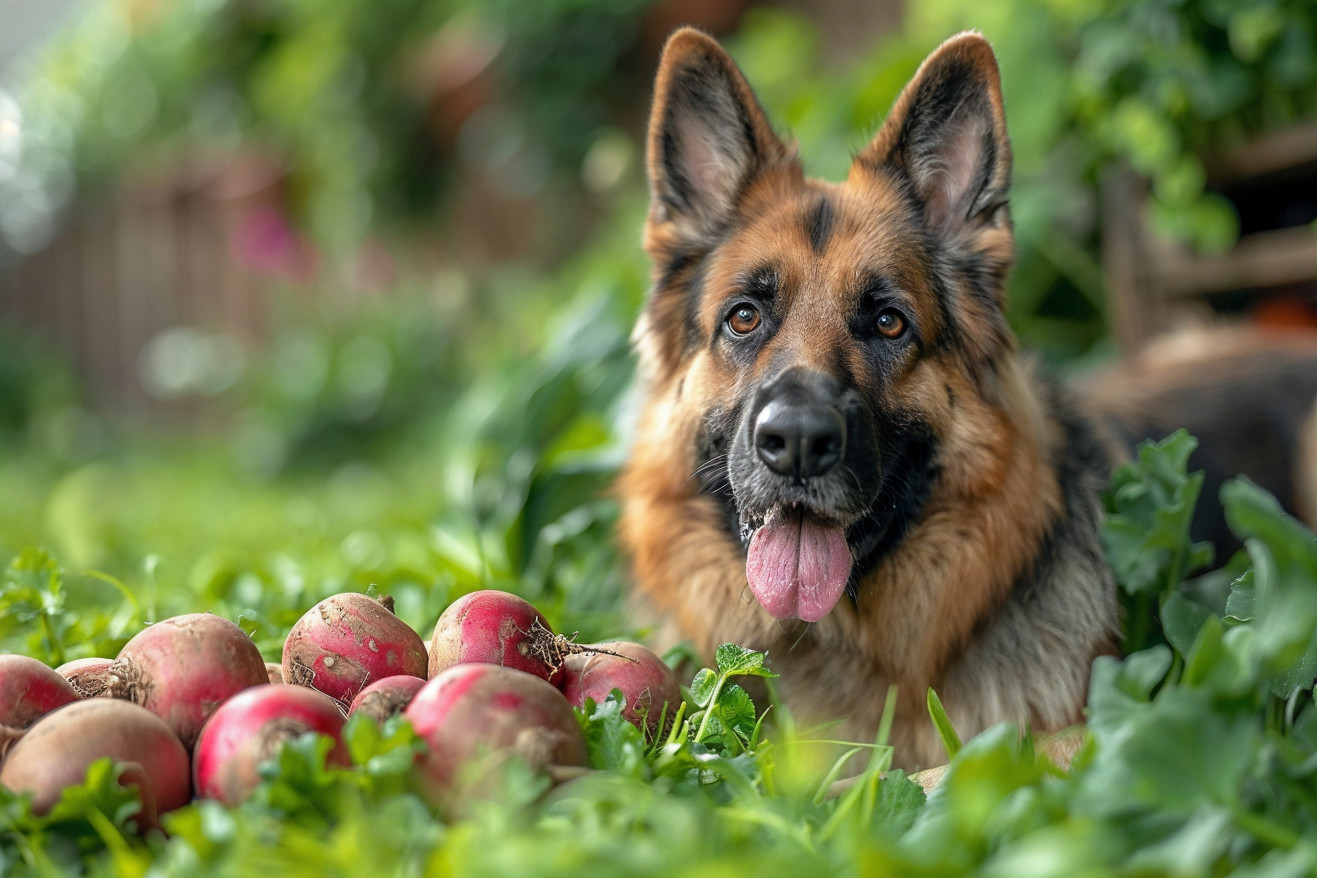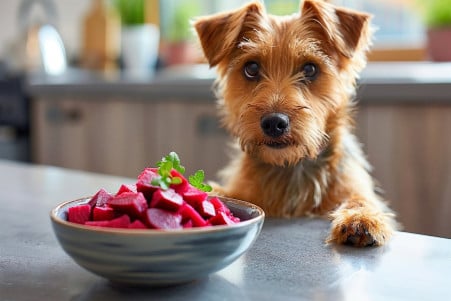Can Dogs Eat Turnips? Decoding the Benefits and Risks for Your Pet
2 March 2024 • Updated 1 March 2024

You may be a fan of turnips, but can your dog safely eat them? Turnips can be a healthy and safe addition to your dog’s diet. They are a good source of fiber, vitamins, and minerals that can help support your dog’s overall well-being.
That said, they should be given in moderation to avoid stomach issues and should be avoided for dogs with thyroid problems. And, as always, make sure to introduce new foods slowly.
This article will help you determine whether or not you should add turnips to your dog’s diet. We’ll do this by looking at veterinary nutritional research and studies on the dietary habits of dogs.
We’ll also cover the nutritional content of turnips, see how it measures up to a dog’s dietary needs, and cover any potential downsides of dogs eating turnips. By combining information from these two areas of study, we hope to give you a well-rounded view of how turnips can be part of a healthy diet for your dog.
Can dogs eat turnips?
Nutritional Benefits of Turnips for Dogs
Turnips are a great source of vitamins and minerals, and dogs can benefit from the nutrients they contain. According to the USDA FoodData Central database, turnips are high in vitamin C, folate, magnesium, and calcium—all of which are important for a dog’s health. For example, vitamin C is an antioxidant that supports the immune system, and folate is important for cell growth and repair, which is important for the nervous system.
Turnips are also high in fiber, with 2.34 grams per cup, which is important for digestive health, according to Medical News Today. Fiber helps keep the digestive system moving and prevents constipation. In addition, turnips are low in calories, with only 36.4 calories per cup, so they can be a good treat for dogs that are watching their weight, according to Verywell Fit.
While turnips are full of important nutrients, it’s important to note that they should be part of a well-rounded diet that meets a dog’s specific needs and not the main source of nutrition. This will help make sure that dogs get the benefits of turnips without upsetting the nutritional balance of their diet.
Be Careful: Risks of Feeding Turnips to Your Dog
While turnips can be a healthy treat for dogs, there are some risks that dog owners should be aware of. Pure Pet Food explains that dogs can experience gastrointestinal upset if they eat too many turnips, which can lead to an upset stomach and diarrhea. To avoid these digestive problems, it’s important to feed turnips in moderation, slowly introducing them into your dog’s diet and monitoring their response.
In addition, turnips contain goitrogens, which can impact thyroid health. Turnips can make symptoms worse in dogs with an existing thyroid condition, like hypothyroidism, because they can suppress thyroid function. As a result, DogTime advises that turnips should be avoided in dogs with thyroid issues.
In addition, it’s important to feed turnips in their raw, unseasoned state. Both Pure Pet Food and DogTime warn that dogs can be sensitive to the additives, seasonings, or spices that are often included in cooked turnip dishes, which can lead to weight gain, pancreatitis, or an upset stomach. In particular, pickled turnips are a no-go because they contain toxic ingredients like garlic and onions, which are toxic to dogs.
By being aware of these risks and feeding turnips in a way that’s safe, you can make sure that this vegetable can be a part of your pet’s diet. As always, it’s a good idea to talk to your vet before introducing new foods to make sure that they’re appropriate for your dog’s individual health concerns.
How to Feed Turnips to Your Dog
If you decide to add turnips to your dog’s diet, there are some important things to keep in mind in order to ensure your dog’s safety and get the most out of the health benefits.
WebMD says that baby turnips are best because they are less bitter, and you should look for turnips that are firm and free of any soft or moldy spots. To make sure your dog can digest the turnips, you should also cook them and make sure they are free of any seasonings or oils that could be harmful.
PetMD says that treats, including turnips and other vegetables, should only make up 10% of your dog’s diet, with the other 90% being a complete and balanced dog food. When it comes to portion sizes, you should also consider your dog’s size and dietary needs, and a few small pieces of turnip every once in a while should be enough.
To mix things up, you can also mix turnips with other dog-safe vegetables like carrots or green beans to make sure your dog is getting a variety of nutrients.
It’s also important to remember that turnips should only be given as an occasional treat and not as a replacement for your dog’s regular meals. That said, mixing turnips with other vegetables can help ensure that your dog is getting a balanced diet and a variety of vitamins and minerals.
What Vegetables Do in a Dog’s Diet
From their origins as strict carnivores, dogs have become omnivores that can eat a wide range of foods, including vegetables. VCA Animal Hospitals notes that a healthy dog diet should include proteins, fats, carbohydrates, minerals, and vitamins, and that dogs’ digestive systems can handle cooked starches and sugars. This is why many commercial dog foods contain vegetables, which can provide the nutrients dogs need to stay healthy.
Cruciferous vegetables like turnips are increasingly being added to pet food formulas. In an interview with Steve Brown, these are referred to as super vegetables, and they contain vitamins, fibers, and phytochemicals that can help the immune system. Dr. Karen Becker notes that while these vegetables can be beneficial, they should be added in moderation to avoid negative side effects.
A healthy dog diet should not be too heavily weighted toward any one type of food. Preventive Vet suggests that vegetables should make up no more than 10% of a dog’s daily calorie intake to avoid potential health problems and ensure that the diet is nutritionally complete. If this is done, pet owners can ensure that their dogs get the varied and nutrient-rich diet they need to stay healthy.
In Conclusion: Turnips Can Be a Healthy Treat for Your Pup
With the right precautions and preparation, turnips can be a healthy and safe treat for your dog. As we’ve learned, turnips have many benefits, including essential vitamins and minerals like vitamin C and fiber, which helps the nervous system and kidney function, according to MasterClass. However, it’s important to remember that moderation is key—not only to avoid digestive issues but also to prevent thyroid suppression, especially in certain breeds, according to DogTime.
Make sure to get your vet’s approval before adding turnip treats to your dog’s diet to make sure they fit your dog’s specific dietary requirements. While turnips can be a great source of nutrients for your dog, they should be part of a balanced diet that includes a variety of nutrient-rich foods that will help keep your dog healthy.
When it comes to making sure your dog is eating the best possible diet, it’s important to keep learning. By keeping up with the latest research and information from reputable sources like the AKC, you can make sure you’re making the best choices for your dog’s health and happiness.


